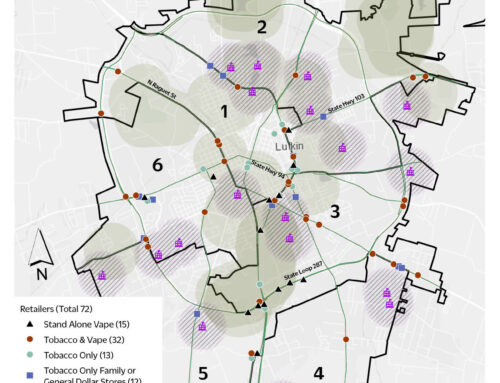Laws and policies adopted at the local level are tailored to their communities, improving health outcomes and reducing inequities. Local laws also complement state or federal policies and provide greater coverage for enforcement inspections of retailers. Preemption laws from a higher level of government can create challenges for local policy innovations and are a key consideration for passing public health measures.
In community-based prevention, researchers and professionals have realized that the best solution for one community may not be the same for another. The best solution to address problems in a community often comes from the folks most heavily impacted. Laws and policies adopted at the local level are key to improving health outcomes and reducing inequities because they are community specific solutions.
An important feature of local laws is the ability to enhance the enforcement and regulatory structure for state or federal policies. When it comes to tobacco point-of-sale policies, FDA inspections and visits through the Synar program are required. However, FDA inspections and Synar program visits only cover a small sample of retailers each year. Local-level policies like local tobacco retailer licensing can require visits to all retailers in a community each year. This may assist in identifying retailers with frequent violations and enforcing stronger penalties on retailers that violate these policies.
In addition, local level policies can be adapted and tailored to be more effective at reducing disparities. For example, restricting tobacco sales in pharmacies may reduce the overall number of tobacco retailers statewide, but in some communities this type of policy may only exacerbate inequities in retailer density. This is the case when there are more pharmacies located in already advantaged neighborhoods where tobacco retailer density is lower. Another benefit to local innovations is that their success can spur statewide change. The Tobacco 21 movement is a great example of this, with many localities successfully raising the minimum legal sales age before statewide policy was enacted. The eventual passage of a federal Tobacco 21 policy can be in part attributed to momentum that began at the local level. A similar process is currently unfolding as localities across the country gain traction with comprehensive flavor bans.
Unfortunately, thanks to industry lobbying, some states use their authority to block local policy innovations. This strategy relies on the legal doctrine of preemption, which allows a higher level of government to limit or even eliminate the power of a lower level of government. Examples of preemption exist in a variety of realms that impact public health, including environmental protections, affordable housing, and regulation of alcohol or sugar-sweetened beverages. The common areas impacted by preemption in tobacco prevention and control policy work are related to youth access, smokefree indoor air and licensure. See the CDC’s STATE System Preemption Fact Sheet for a summary of the preemption status for each state in these three categories.
Starting this summer, Counter Tools and GHEA will be launching a three-part local control webinar series. The series will include guest speakers, resources, and stories of local control efforts from the fields of tobacco and alcohol control. Stay tuned for registration details coming soon!
Additional Resources
Local control and preemption within the field of tobacco prevention and control:
- Tobacco Point of Sale Preemption Playbook (Counter Tools & ChangeLab Solutions)
- Untangling The Preemption Doctrine in Tobacco Control (Public Health Law Center)
- Preemption: The Biggest Challenge to Tobacco Control (Public Health Law Center)
- Checked at the Check-Out Counter: Preemption at the Tobacco Point of Sale (Public Health Law Center)
- State Legislated Actions on Tobacco Issues (SLATI) (American Lung Association)
- Protect Local Control (Americans for Nonsmokers’ Rights)
This post was originally published as a feature article for The Geographic Health Equity Alliance (GHEA), a CADCA initiative. GHEA is a CDC funded National Network dedicated to reducing geographic health disparities related to tobacco and cancer.





